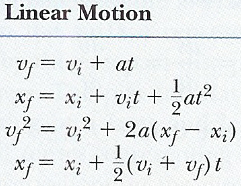These were taken by Jason Hoisington
Did you know that the motion you travel off of a jump can be calculated
so you will know where you will land? Yes, it can. From projectile motion
kinematic equations values such as your velocity, max height, and farthest
distance can be calculated from these equations.
In the pictures above, I am going off a jump that sent me off into the air in a parabola shaped path. I did not start at the top of the hill because I wanted to walk away from the hill in one piece, but I started half way up between the top and the jump. I did have to hold onto the sled when I went off the jump, other wise I would end up using my jeans as a sled instead.
There are angles which are helpful to know when you want to make a jump, such as the one in the picture above. Depending on what you are trying to do with the jump, there are angles which give you the maximum height or the longest distance traveled. From the picture below, you can see that at different angles, the object being launched will reach different heights and land at different distances. The graph below shows the distances and velocities just when the initial velocity is 50 m/s. For different velocities you will reach different heights and distances, but the maximum height, or "air" off the jump, will be reached when it is at 90 degrees. Having a jump made at 90 degrees though, may not be a practical thing to do. You will end up doing a face plant into a wall of snow and ice which would hurt really bad, especially if you were traveling very fast. Your best bet would to make as steep of a jump as possible through trial and error that wouldn't cause you to smack into the jump and take it out. This would hurt really bad, and would cause your friends to burst out laughing in the snow once they saw that you were all right.
In the pictures above, I am going off a jump that sent me off into the air in a parabola shaped path. I did not start at the top of the hill because I wanted to walk away from the hill in one piece, but I started half way up between the top and the jump. I did have to hold onto the sled when I went off the jump, other wise I would end up using my jeans as a sled instead.
There are angles which are helpful to know when you want to make a jump, such as the one in the picture above. Depending on what you are trying to do with the jump, there are angles which give you the maximum height or the longest distance traveled. From the picture below, you can see that at different angles, the object being launched will reach different heights and land at different distances. The graph below shows the distances and velocities just when the initial velocity is 50 m/s. For different velocities you will reach different heights and distances, but the maximum height, or "air" off the jump, will be reached when it is at 90 degrees. Having a jump made at 90 degrees though, may not be a practical thing to do. You will end up doing a face plant into a wall of snow and ice which would hurt really bad, especially if you were traveling very fast. Your best bet would to make as steep of a jump as possible through trial and error that wouldn't cause you to smack into the jump and take it out. This would hurt really bad, and would cause your friends to burst out laughing in the snow once they saw that you were all right.

